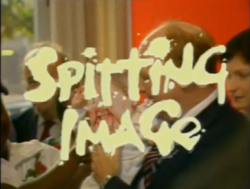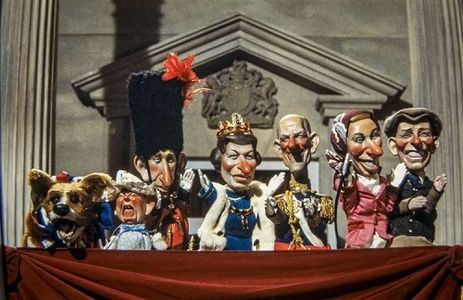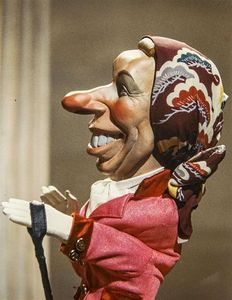Spitting Image (lost pilots of British satirical puppet television show; 1983)
Spitting Image is a British satirical comedy puppet television show. Originally broadcast on ITV from 1984 to 1996, and on BritBox from 2020 to 2021, it provided a satirical outlook of current events through puppets resembling uncanny caricatures of notable British and international people. Prior to the show being greenlit, two pilots were filmed in 1983, which featured very different puppets to the ones utilised in the main series.
Background
Spitting Image was originally conceptualised by Martin Lambie-Nairn, who saw the potential of Peter Fluck and Roger Law's work.[1][2] Prior to Spitting Image, Fluck and Law had illustrated newspapers articles via caricature puppets, which Lambie-Nairn believed could translate effectively to television.[3][1] Originally titled Rubber News, the show faced a few hurdles prior to being televised in 1984.[2] Among these included concerns from television companies that such a show would only appeal to children, as well as conflicts about what Spitting Image should satirise.[4][1] For instance, original writer and producer Tony Hendra felt the show needed to be political-based and decidedly against Margaret Thatcher's government, whereas director John Lloyd believed it should not be overly-political.[5] Eventually, the show would branch out to satirise all areas of popular British culture, including the Royal Family, celebrities, and sport.[6][7][8]
First airing on ITV in 1984, the arrival of future Red Dwarf creators Rob Grant and Doug Naylor as head writers contributed towards the show garnering significant popularity, attracting around 15 million viewers at its peak.[1][7][8] It won two BAFTAs during its original run, and is credited for launching the careers of various comedians and actors, including but not limited to Harry Enfield, Steve Coogan, and John Sessions.[7][8] The show was ultimately cancelled in 1996 because of falling ratings and the shear cost of producing the puppets.[2][8] A revival on BritBox began in 2020, lasting two series before facing cancellation.[9]
The Pre-Pilot
By Autumn 1981, Fluck and Law began pitching the show to computing industry entrepreneur Clive Sinclair.[10] Sinclair was impressed with the concept, and a provisional deal to provide three cash instalments totalling £60,000 was originally reached.[11] In January 1982, Lambie-Nairn and Ian St John established Spit 'N' Image Productions Limited, with the plan being that Sinclair, and companies Robinson Lambie-Nairn (RLN) and Tooth and Claw.[11] After receiving the first £20,000 instalment, work had begun on the pilot by September 1982, with the aim to finish it by the end of November that same year.[12] The creators believed the entirety of the promised £60,000 would be absorbed into the pilot's production.[13] Were it to fail in any way, Spit 'N' Image Productions would end up bankrupt.[13] The project nearly ended in disaster when Sinclair decided not to partake in production any further, most likely due to the slow progress being made.[14] The remaining £40,000 would not be forthcoming.[14]
Spit 'N' Image Productions therefore urgently required a new benefactor to save the project.[14] This came in part when Central Independent Television's director of programmes Charles Denton contacted the company, believing the concept was a good one and agreeing to provide £60,000 for the pilot.[14] There was a catch: a pre-pilot consisting of ten minutes' worth of footage needed to be filmed before the money was distributed.[14] Therefore, Roger Greenwood, a former IBM employee and owner of training film company Esprit, was approached.[15][14] Greenwood agreed to provide £30,000 in exchange for utilising the puppets for training films.[15][14] With money now forthcoming, the pre-pilot was filmed on 30th January 1983.[16][17] Harnessing a script written by John Lloyd and Ben Elton, various segments were recorded.[17][16] Among these included a caricature of US President Ronald Reagan miming to a then-recent House of Commons speech he made, as well as having Labour leader Michael Foot end up in trouble with curtains.[17][16] A few songs were played, such as "Drop Kick me to Jesus through the Goalposts of Life".[17]
The Pilot
Lasting under ten minutes, the pre-pilot thrilled Central Independent Television, who consequently agreed to financially back a proper 30-minute pilot.[18][17] With an enhanced budget of £68,000 and a long deadline of Summer 1983, eight puppeteers were selected to not only control the characters but also provide voices.[16][18][17] Among the puppeteers included Louise Gold, most known for her work on The Muppet Show.[18][16] She also worked on the pre-pilot, and fulfilled the role of the puppeteering consultant, responsible for selecting and training the other puppeteers.[18][16] One of them was Chris Barrie, who had no prior experience of puppetry beforehand.[16] Nevertheless, he would be a key vocal impressionist for the show's many series. Gold also established a PE area, as controlling a puppet through the wake of constant lighting and camera changes required sufficient puppeteer fitness.[18]
Titled "UNTV", £33,234 of the pilot's £60,000 budget went into puppet construction, while £19,761 was allocated for the studio, and set costs took £16,475.[19] Following rehearsal from mid-May to 24th June, filming for UNTV commenced from 27th to 30th June 1983.[16][19] The 30-minute pilot followed a similar format to the main series, with an emphasis on international politics.[19][16] The pilot began with a caricature of then UN secretary general Javier Pérez de Cuéllar guiding viewers to his his office, monitoring the world via the presence of various installed TV screens.[19] Among statements he makes includes "Don't count your chickens before they're deserted, as they say in Argentina", a reference to the recently-ended Falklands War.[19] The next scene showed a fireside chat from President Ronald Reagan, who demonstrates gun superiority by shooting butter and stating "See what I mean? The butter is helpless, impotent. Does it fight back? No. It's got no balls, butter. It just spatters all over the place looking greasy. Basically, butter is weird".[19]
Three segments were situated in London.[19] It started with Prime Minister Margaret Thatcher and Norman Tebbit opening various mail.[19] However, they find that all of them are laced with explosives, making them remark over the seeming absence of actual letters.[19] Meanwhile, Labour leader Michael Foot is in sorrow regarding rising unemployment, primarily as his Ebbw Vale friends are also now feeling its effects.[19] At Buckingham Palace, trouble emerges when one of the Queen's corgis bites the Royal Baby, presumably Prince William, and throws him off a Palace balcony.[19] Over in Moscow, live on primetime television, Soviet Union leader Yuri Andropov's interrogation methods almost results in the deaths of most targets.[19] Libyan leader Muammar Gaddafi meanwhile showcases his magical powers, cutting someone in half without needing illusion.[19]
Finally, five candidates are aiming to become the next Japanese Ambassador to the United States.[19] They have reached the final stage after demonstrating their supposed individuality.[19] However, when the interviewer explains that the US has racially stereotyped Japanese people as having the same appearance, it is revealed none of the candidates know who they or the others are.[19] One candidate, having humiliated himself in the presence of Emperor Hirohito, commits seppuku.[19][16] This, however, leads the others to either commit seppuku out of shame or being unimpressed with the prior seppuku and attempting to outdo it.[19][16] After all five candidates are dead, the Emperor denounces their suicides and decides to outdo them, cutting his fingers off and mutilating his stomach, before the sketch ends just as he attempts to lob his nose off with a knife.[19] This proved to be the most difficult to film, as assistants needed to pass meat over to the puppeteers above, while the puppeteers sometimes had to get their heads out to see the action and properly position their puppets.[19] In some takes, the top of the puppeteers' heads could be seen.[19]
Despite the technical difficulties involved in filming it, most were satisfied with the pilot, particularly with the seppuku segment.[19][16] However, Hendra was angry with Lloyd's meddling with the script and set, leading to further disagreements between the pair that caused Hendra's early departure from the show.[19][5] Most importantly, Denton was convinced of the show's potential; initially, he wanted Spitting Image to have 26 episodes per series.[19] This was later negotiated down to 13, to avoid a pressurising schedule and overexposure.[19] The first episode would air on 26th February 1984.[20]
Availability
Despite the pre-pilot and pilot's roles in ensuring Spiting Image made it to television screens, neither ended up being aired.[19] According to Tooth & Claw: The Inside Story of Spitting Image, a major factor was that producing an untransmitted pilot was considerably cheaper than an aired programme.[19] Another concern was that the pilot's contents would be significantly outdated were it to air in modern times.[19]
On 14th November 2018, it was reported that Law had donated the show's programme archive to the University of Cambridge.[21][7] Among items the university received included a Margaret Thatcher puppet, all episode scripts, and an apparent copy of the pilot.[7][21] However, a subsequent article from Cambridge Independent contradicts the supposed videotape, as it reports that no footage of the pilot was available and that only a typed script is known to still exist.[22] A year following the University of Cambridge's acquirement, archivist Sian Collins was searching through the collection when she discovered a set of photographs categorised under "Pilot".[22] Consisting of images from the Royal Family segment, the puppets are strikingly different from those in the main show.[22] The future changes may have reflected the show's growing team of puppet makers, who Law felt were better caricaturists than himself or Fluck.[2]
Despite Collins' discovery, no footage has been recovered.[22] It is theorised that a VHS copy may exist, but due to its age, it may have degraded over time and may have ultimately become unwatchable.[22]
Gallery
Images
References
- ↑ 1.0 1.1 1.2 1.3 We Heart detailing Spitting Images' origins, and its overall success. Retrieved 5th Mar '23
- ↑ 2.0 2.1 2.2 2.3 British Cartoon Archive summarising the career of Law, and the show's rise and fall. Retrieved 5th Mar '23
- ↑ '80s Actual providing some of the work Fluck and Law established prior to Spitting Image. Retrieved 5th Mar '23
- ↑ The Telegraph detailing how many television companies rejected the show in the belief it would appeal only to children. Retrieved 5th Mar '23
- ↑ 5.0 5.1 Independent summarising the life and career of Hendra, including his conflicts with Lloyd on the show's direction. Retrieved 5th Mar '23
- ↑ British Film Institute detailing the show's premise, and its ambition to satirise all. Retrieved 5th Mar '23
- ↑ 7.0 7.1 7.2 7.3 7.4 University of Cambridge announcing it had acquired the programme archive, including materials related to the pilot. Retrieved 5th Mar '23
- ↑ 8.0 8.1 8.2 8.3 Archived Digital Spy reflecting on the show 30 years following its debut. Retrieved 5th Mar '23
- ↑ British Comedy Guide reporting on Spitting Image's second cancellation on BritBox. Retrieved 5th Mar '23
- ↑ Tooth & Claw: The Inside Story of Spitting Image noting Fluck and Law reaching out to Sinclair for financial backing. Retrieved 5th Mar '23
- ↑ 11.0 11.1 Tooth & Claw: The Inside Story of Spitting Image detailing Sinclair provisionally agreeing to provide £60,000, and the formation of Spit'N'Image Productions Limited. Retrieved 5th Mar '23
- ↑ Tooth & Claw: The Inside Story of Spitting Image noting the project received £20,000 from Sinclair. Retrieved 5th Mar '23
- ↑ 13.0 13.1 Tooth & Claw: The Inside Story of Spitting Image noting that the £60,000 would be entirely required for the pilot, meaning the pilot's success was crucial to avoid bankruptcy. Retrieved 5th Mar '23
- ↑ 14.0 14.1 14.2 14.3 14.4 14.5 14.6 Tooth & Claw: The Inside Story of Spitting Image detailing Sinclair backing out of the project, and Central Independent Television making a £60,000 offer providing a pre-pilot was filmed. Retrieved 5th Mar '23
- ↑ 15.0 15.1 Tooth & Claw: The Inside Story of Spitting Image detailing Greenwood's backing of the project. Retrieved 5th Mar '23
- ↑ 16.00 16.01 16.02 16.03 16.04 16.05 16.06 16.07 16.08 16.09 16.10 16.11 Emma at Qsulis summarising the two pilots, including listing the cast and crew. Retrieved 5th Mar '23
- ↑ 17.0 17.1 17.2 17.3 17.4 17.5 Tooth & Claw: The Inside Story of Spitting Image summarising the pre-pilot and its success that led to a full pilot being filmed. Retrieved 5th Mar '23
- ↑ 18.0 18.1 18.2 18.3 18.4 Tooth & Claw: The Inside Story of Spitting Image detailing Gold's involvement in the pilots. Retrieved 5th Mar '23
- ↑ 19.00 19.01 19.02 19.03 19.04 19.05 19.06 19.07 19.08 19.09 19.10 19.11 19.12 19.13 19.14 19.15 19.16 19.17 19.18 19.19 19.20 19.21 19.22 19.23 19.24 19.25 19.26 19.27 Cookd and Bombd providing an extract from Tooth & Claw: The Inside Story of Spitting Image detailing the pilot. Retrieved 5th Mar '23
- ↑ British Comedy Guide listing the episodes of Series 1. Retrieved 5th Mar '23
- ↑ 21.0 21.1 Sky News reporting on the University of Cambridge's acquirement of the programme archive. Retrieved 5th Mar '23
- ↑ 22.0 22.1 22.2 22.3 22.4 Cambridge Independent reporting on Collins discovering photographs from the pilot. Retrieved 5th Mar '23



